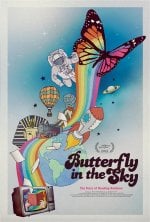Latest Movie Trailers & Videos
Touch
Official Trailer
Longlegs
Dirty: Part Two
Jim Henson Idea Man
Official Trailer
Ride
Official Trailer
In Good Hands 2
Date Announcement
School of Magical Animals 2
Official Trailer
Summer Camp
Official Trailer
Prom Dates
Official Trailer
She Rises Up
Official Trailer
Dead Wrong
Official Trailer
Cora Bora
Official Trailer
The Exorcism
Official Trailer
Blink Twice
Official Trailer
Day Labor
Official Trailer
The Last Movie Ever Made
Official Trailer
Invisible Nation
Official Trailer
Hazard
Official Trailer
Sweetland
Official Trailer
Sira
Official Trailer
Power
Official Trailer
Dinotrux (series)
Official Trailer
2 Minutes of Fame
Official Trailer
Brave New World (series)
Official Trailer
Princess Halle and the Jester
Official Trailer
New Movies Coming Out This Week
City Hunter
Netflix
Challengers
Nationwide
Unsung Hero
Nationwide
Boy Kills World
Limited
Nowhere Special
Limited
Knuckles (limited serie...
Paramount+
Cash Out
Limited
Cinderella's Revenge
Limited
Breathe
Limited
The Feeling That the Ti...
Limited
Infested
Shudder
Bloodline Killer
VOD / Digital
Dancing Village: The Cu...
Limited
Humane
Limited
The King Tide
Limited
Break
Limited
Terrestrial Verses
Limited
Impulse
VOD / Digital
The Barkers: Mind the C...
VOD / Digital
My Divorce Party
VOD / Digital
Stargazer
VOD / Digital
Butterfly in the Sky
VOD / Digital
The Idea of You
Prime Video
Jules and Jim Movie Review
originally posted many years ago
Jules and Jim is among the masterpieces of the French New Wave and may be considered the finest achievement of that movement. Jules and Jim is the ultimate menage-a-trois, and certainly one of the most poetic films of the French New Wave. Director Francois Truffaut gathered inspiration for the movie from novelist Henri-Pierre Roche, and was able to shape this truly original story into a pure picture of his own generation. The film acknowledges the time period, for it chronicles 30 years in the lives of its characters, opening brightly in La Belle Epoche and closing in the grim era of the Depression and the rise of Hitler. Cinematographer, Raoul Coutard, and Truffaut utilize many of their trademark techniques: jump cuts, freeze frames, narration, and masking off parts of the screen.
Widely acknowledged as a masterpiece during the early 1960s, this film was quite daring for its time. It questioned some of the basic assumptions about human relationships and offered a vision of an alternative kind of relationship. The main female character, Catherine (Jeanne Moreau), is the consummate free spirit and an extreme representation of the modern woman. Catherine is a life force fighting for equality with her male counterparts, Jules and Jim. Austrian stage actor Oskar Werner (Jules) and the French actor Henri Serre (Jim), were both comparatively unknown in France, and were picked up by Truffaut for personal reasons. Truffaut immediately spotted Werner’s performance in Max Ophul’s film Lola Montes and chose Serre mainly for his physical resemblance to the young Henri-Pierre Roche’-tall and thin, with a deep but gentle voice. Catherine, yielding to her mad impulses, harbors a need for love and security, which she hopes to find in Jules and Jim, who offer her sanctuary. As the impulsive femme fatale she is totally bewitching, but it is her scenes where she displays emotional insecurity that are the most poignant and engaging. She sings Cyrus Bazziak’s "Le Tourbillon de la vie" as if it were the theme of her life. The playfulness of the three central characters is reflected in some equally playful and imaginative photography and editing.
Circles and triangles were the focus of the cinematography. Their presence in the three separate windows of the seashore house illustrates this. The sharp angular pans of the camera keep the viewer wondering in which direction love must flow. But it is the spinning circularity of the cinemascope most viewers recognize. The circle is the most repeated element throughout the movie appearing in the cafe tables, bicycles, the tadpoles swimming around their bowl, and in Catherine’s cosmology which holds the world to be an inverted bowl. The motif of circles used in the plot, song, and camera work, at first presents a feeling of freedom and expansiveness, then slowly closing inward, more like a spiral, evoking the feeling of entrapment.
Art is another such measure, and Jules and Jim is a catalogue of the arts. Scattered throughout the film are references to old films, photography and slideshows, statues, paintings, novels, the theatre, and music. Many critics declare this film a story about the drive to recognize art and it’s endless presence. However, Jules and Jim never lets up in its drive to give meaning and expression to the vitality of life. This was the ambition sought by New Wave films, and this movie is its definitive example.
After the commercial failure of Truffaut’s previous film, Tirez sur le pianiste, he was compelled to make Jules and Jim on a modest budget (often using his friends’ homes for location shooting). He was also determined to make a successful film – without another success he would find it difficult to finance future films. As a result, he created a film that was more appeasing to the public, for which he and other New Wave directors had not previously strived. Despite being initially banned in Italy and receiving an over-18 classification in France, Jules and Jim quickly became a popular and successful film across Europe and in the United States.
As the most astonishing film of the French New Wave, Truffaut has conceived a fragment of cinema that is wonderfully alluring and a joy to watch. Functioning on several levels, the film can be treated as anything from a simple love story to an allegory on the fractured state of Europe between the World Wars. It’s difficult to describe just why the film is so physically entrancing. With the addition of excellent, natural and sympathetic acting from the three main leads we are drawn into caring for their future, even for difficult, manipulative Catherine.
When I first heard of this movie in my early film-watching career of junior high school, the underlying symbols and meanings to each individual character and their contribution to the story entranced me. I was genuinely surprised a few years later when Cameron Crowe paid homage to Truffaut’s film in his movie Vanilla Sky. In the background you were able to see the movie poster for Jules and Jim. In addition to that acknowledgement, Crowe utilized the freeze frame method during the romantic love scene to capture those moments of poetic affinities between the central characters. Previously in film class we sat down and tuned senses to the magic realism of Jean-Pierre Jeunet’s film, Amelie. The main character, Amelie, made reference to the movie Jules and Jim as being a movie she goes to watch with the general public. These two notable references in today’s films prove to make clear the amount of international success the film had made and the impact it left 40 years after the making.
Today, the film is often referred to and held up as a prime example of New Wave cinema. Jules and Jim secured Francois Truffaut’s position as one of the most highly regarded directors of his generation. It is a film that cannot fail to leave its audience unmoved. It’s a unique film about life – the comedy and the tragedy, mixed together in the turbulent whirlpool of life.
Widely acknowledged as a masterpiece during the early 1960s, this film was quite daring for its time. It questioned some of the basic assumptions about human relationships and offered a vision of an alternative kind of relationship. The main female character, Catherine (Jeanne Moreau), is the consummate free spirit and an extreme representation of the modern woman. Catherine is a life force fighting for equality with her male counterparts, Jules and Jim. Austrian stage actor Oskar Werner (Jules) and the French actor Henri Serre (Jim), were both comparatively unknown in France, and were picked up by Truffaut for personal reasons. Truffaut immediately spotted Werner’s performance in Max Ophul’s film Lola Montes and chose Serre mainly for his physical resemblance to the young Henri-Pierre Roche’-tall and thin, with a deep but gentle voice. Catherine, yielding to her mad impulses, harbors a need for love and security, which she hopes to find in Jules and Jim, who offer her sanctuary. As the impulsive femme fatale she is totally bewitching, but it is her scenes where she displays emotional insecurity that are the most poignant and engaging. She sings Cyrus Bazziak’s "Le Tourbillon de la vie" as if it were the theme of her life. The playfulness of the three central characters is reflected in some equally playful and imaginative photography and editing.
Circles and triangles were the focus of the cinematography. Their presence in the three separate windows of the seashore house illustrates this. The sharp angular pans of the camera keep the viewer wondering in which direction love must flow. But it is the spinning circularity of the cinemascope most viewers recognize. The circle is the most repeated element throughout the movie appearing in the cafe tables, bicycles, the tadpoles swimming around their bowl, and in Catherine’s cosmology which holds the world to be an inverted bowl. The motif of circles used in the plot, song, and camera work, at first presents a feeling of freedom and expansiveness, then slowly closing inward, more like a spiral, evoking the feeling of entrapment.
Art is another such measure, and Jules and Jim is a catalogue of the arts. Scattered throughout the film are references to old films, photography and slideshows, statues, paintings, novels, the theatre, and music. Many critics declare this film a story about the drive to recognize art and it’s endless presence. However, Jules and Jim never lets up in its drive to give meaning and expression to the vitality of life. This was the ambition sought by New Wave films, and this movie is its definitive example.
After the commercial failure of Truffaut’s previous film, Tirez sur le pianiste, he was compelled to make Jules and Jim on a modest budget (often using his friends’ homes for location shooting). He was also determined to make a successful film – without another success he would find it difficult to finance future films. As a result, he created a film that was more appeasing to the public, for which he and other New Wave directors had not previously strived. Despite being initially banned in Italy and receiving an over-18 classification in France, Jules and Jim quickly became a popular and successful film across Europe and in the United States.
As the most astonishing film of the French New Wave, Truffaut has conceived a fragment of cinema that is wonderfully alluring and a joy to watch. Functioning on several levels, the film can be treated as anything from a simple love story to an allegory on the fractured state of Europe between the World Wars. It’s difficult to describe just why the film is so physically entrancing. With the addition of excellent, natural and sympathetic acting from the three main leads we are drawn into caring for their future, even for difficult, manipulative Catherine.
When I first heard of this movie in my early film-watching career of junior high school, the underlying symbols and meanings to each individual character and their contribution to the story entranced me. I was genuinely surprised a few years later when Cameron Crowe paid homage to Truffaut’s film in his movie Vanilla Sky. In the background you were able to see the movie poster for Jules and Jim. In addition to that acknowledgement, Crowe utilized the freeze frame method during the romantic love scene to capture those moments of poetic affinities between the central characters. Previously in film class we sat down and tuned senses to the magic realism of Jean-Pierre Jeunet’s film, Amelie. The main character, Amelie, made reference to the movie Jules and Jim as being a movie she goes to watch with the general public. These two notable references in today’s films prove to make clear the amount of international success the film had made and the impact it left 40 years after the making.
Today, the film is often referred to and held up as a prime example of New Wave cinema. Jules and Jim secured Francois Truffaut’s position as one of the most highly regarded directors of his generation. It is a film that cannot fail to leave its audience unmoved. It’s a unique film about life – the comedy and the tragedy, mixed together in the turbulent whirlpool of life.
You're browsing the archives, check out the latest movie news.





















































